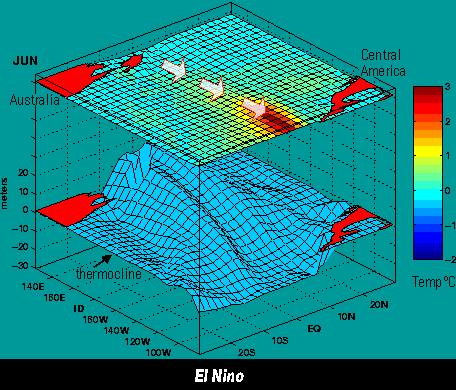El Nino translates from Spanish as ‘the boy-child’ (the opposite event is La Nina ).
Peruvian fisherman originally used the term referring to the Christ as a child. This was used to describe the appearance, around Christmas, of a warm ocean current off the South American coast. Today, the term El Niño refers to the extensive warming of the central and eastern Pacific that leads to a major shift in weather patterns across the Pacific. In Australia, and more so for eastern Australia, El Niño events are associated with an increased probability of drier conditions.
El Nino In a narrow sense, it’s a giant puddle of heated water that sloshes across the Pacific Ocean. From NASA satellites, the big picture can be seen; a massive pool of warm seawater, half again as large as the United States, builds in the western Pacific over a period of months. This gargantuan wedge of warm sea contains 20 or 30 times as much water as all the Great Lakes in America put together.

In one sense El Nino is like an iceberg; most of it is submerged, but part of it sticks out above the sea’s surface, as the wedge floats in the surrounding ocean. Partly because warm water is less dense than cool water, and also partly because El Niño waters are less salty than normal seawater. (It’s always raining over an El Nino, and the rainwater dilutes the sea.) Both of these conditions contribute to buoyancy. A sharp temperature and density change, called the thermocline, floats about 100 meters below the surface, and marks the bottom of this warm “iceberg.” The top layer of water may protrude 150 or more centimeters above sea level. This isn’t so hard to picture if you think about tides, which also pile water up above sea level.
El Niño’s energy reserve is vast, almost inconceivable. It contains more energy than has been procured from all the fossil fuels burned in the United States since the beginning of the century – that’s all the gasoline in all the cars, the coal in all the power plants, the natural gas in all the furnaces. It would take more than a million large power plants, at 1,000 megawatts each, running full tilt for a year, to heat the ocean that much. Or if you want to think in more violent terms, that’s all the energy produced by about half a million 20 megaton hydrogen bombs, gone into heating water.
In a sense, El Niño is like a slow-motion explosion of pent-up heat that makes a violent killer out of a small tropical storm…or that can bring life-giving rains to a parched Chilean desert. It is because they hoard such stupendous quantities of energy that El Niños are second only to the change of seasons as shapers of global weather. Although El Niño’s water pooling phenomenon is regional, the effects this has on climate truly stretch around the world, as ocean currents and atmospheric winds ferry its monumental power out of the tropics and around the planet.
While economic impacts tend to cancel each other out at the national level, El Niño does cause real economic losses such as storm damage or crop losses, which are not offset by gains elsewhere. These are losses that can’t be prevented or reduced by a better forecast or mitigation. For example, on average, El Niños result in agricultural losses approaching $2 billion, or nearly 1-2 percent of total crop output. In the 1997-98 El Niño, property losses were estimated at nearly $2.6 billion.
